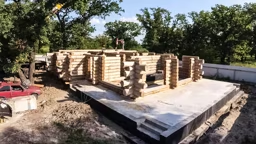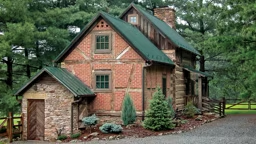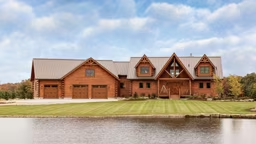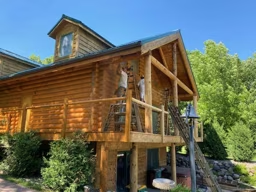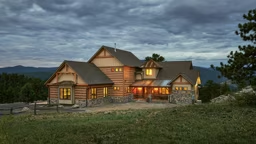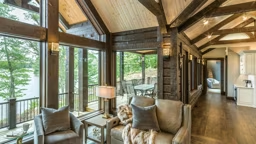
There’s something to be said for the igloo. Made from blocks of snow, generally in the form of a dome, igloos are specially designed to keep heat in and cold out — and it works! While it may be as frigid as 50 degrees below zero outdoors, inside it’s downright comfortable, with temps reaching 60 degrees or more. This is because the snow acts as an insulator, and as the outer layer of ice melts and refreezes, an airtight shell is formed.
No matter where you are, when the weather gets harsh, the most important thing is to have a strong structure around you, so we sought out smart solutions for building in the chilliest regions of the U.S. Read on for our top 14 ways to create a home that’s warm and wonderful when the weather outside is frightful.
1. Know Your Local Codes
Local building codes will dictate how much snow load your roof should safely support. This can vary from 110 pounds per square foot in the Rockies to 250 pounds in the Sierra Nevadas. Talk with a builder or codes official early in the process so you have an idea of what’s required and how that will affect your construction costs.
2. Choosing a Roof for Snow
Some experts believe that layers of snow on your roof offer extra insulation for your home, while others think it’s best to shed the snow. Ask your builder what he or she suggests. If you go the shedding route, metal is the material that sheds the best, and the roof should have a steep pitch to allow it to slide with ease. Regardless of the type of roofing you choose, specify an ice-shield underlayment to protect your interior from potential leaks, even if it’s not mandated by code.
3. Research Hearth Options
Cold nights and a warm fire go together like popcorn and butter, but your choice of hearth products will depend on which fuels are accessible — and permissible — in your area. There are eight basic fuels from which to choose: wood, natural gas, propane, coal, oil, electricity, corn and wood pellets. In terms of units, your choices are wood-burning fireplaces, stoves, masonry heaters and inserts (either gas or electric), and there are pros and cons to each. For example, nothing beats the ambiance and aroma of a wood fire. But cleaning up ashes can be messy, and you have to keep the chimney free of creosote. An electric fire is convenient (and new models produce flames that are more realistic than in the past), but you can’t toast marshmallows over it, and you don’t get the crackle and fragrance of wood. Research your options thoroughly and consider your lifestyle when you choose.
4. Add Large Overhangs
To create flexible outdoor living spaces — and minimize your home’s maintenance — integrate covered porches, decks and balconies in your design. To further protect exterior logs from driving rain, blizzards or even sun damage, include deep eaves and overhangs into your roof. Many manufacturers recommend a minimum of a 4-foot overhang, but deeper (within reason) is better.

5. Strategize Your Floor Plan
For the ultimate sloppy-weather abode, choose a floor plan with a large mudroom for drying and storing wet winter gear. And in addition to a garage, include a portico to keep you and your guests dry as you unload luggage, groceries or holiday gifts outside the front door.
6. Full or Half Logs
Deciding between full and half logs is usually simply a matter of preference, since both offer energy efficiency. The advantage of a full log home lies in its thermal mass, which keeps homes cool in the summer and warm in the winter. Half-logs are applied to conventional 2-by-6 (stick frame) construction or a structurally insulated panel (SIP) wall system. If you’re curious about the physics of both options, visit the Log & Timber Homes Council at loghomes.org.
7. Add a Humidifier
In the winter, indoor air humidity levels can fall as low as five percent (even the Sahara Desert has 25 percent humidity!), which can cause logs to check, damage wood furniture, dehydrate your skin and even cause respiratory issues. For relief for you and your home, buy a whole-house humidifier, usually installed onto a forced-air furnace. While you’re at it, consider an air-purifying system to remove particulate matter from your interior air.
8. Don't Forget About Flooring
When it comes to floor coverings in snow-covered climes, tile is a can’t-miss choice. Not only is it resilient and easy to clean, it has the capacity to absorb and radiate warmth in the winter (just like the thermal mass found in logs). You can turn up the heat a notch by incorporating radiant in-floor heating, either in targeted rooms, like the mudroom or master bath, or throughout the house.
9. Consider an Insulated Garage Door
Building your garage into the basement level can be an affordable and efficient option, but you’d be smart to splurge on an insulated garage door. For a few thousand dollars more, an insulated door will not only help save money on your energy bills, it could help keep your car engine from freezing when temperatures take a nose dive.

10. Don't Let Windows Be the Weakest Link
The weakest link in any home’s thermal envelope is the windows. For maximum energy efficiency, invest in high-quality windows with a low U-value (the lower the number, the better the window’s performance). They will be well worth the premium you pay, both in terms of your long-term energy usage/costs and your comfort. Insulated window cladding also provides a big boost to performance.
11. Plan for Backup Power
In anticipation of downed powerlines in an ice storm, plan more than one power source for your log home, especially if you have a natural gas fireplace that requires electricity to operate. Propane-powered generators that kick on automatically the instant the power goes out are popular options.
12. Design Your Driveway for Winter
The longer your driveway, the more costly snow removal will be — either in dollars or in backaches. You may want to consider positioning your home closer to the road to shorten the drive to your door. Regardless of length, design your driveway with areas to put the white stuff after plowing, as well as incorporating space for guests to park easily. And don’t forget to install adequate path lighting to prevent slips and falls.
13. Plan a Plentiful Pantry
If getting snowed in for extended periods of time is a real possibility, incorporate a large pantry for dry and canned goods, as well as a basement larder for cold storage. An extra fridge and freezer can’t hurt either.
14. Prepare for a Tight Schedule
Finally, when building in the high country, snow arrives early and stays late (some areas can still have a blanket of white well into June), which means your construction season is shorter. Select a builder who has a proven track record of completing high-quality log homes on tight deadlines.




